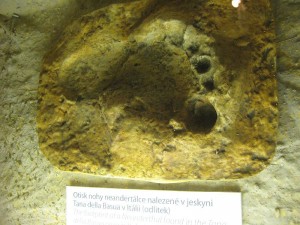Neandertals Died Out Earlier Than Previously Thought
Posted by: Loren Coleman on May 18th, 2011

The following new press release gives an opposite point of view from another posting here at Cryptomundo:

Direct dating of a fossil of a Neanderthal infant suggests that Neandertals probably died out earlier than previously thought. Researchers have dated a Neandertal fossil discovered in a significant cave site in Russia in the northern Caucasus, and found it to be 10,000 years older than previous research had suggested. This new evidence throws into doubt the theory that Neanderthals and modern humans interacted for thousands of years.
Instead, the researchers believe any co-existence between Neandertals and modern humans is likely to have been much more restricted, perhaps a few hundred years. It could even mean that in some areas Neandertals had become extinct before anatomically modern humans moved out of Africa.The research, directed by University College Cork and the University of Oxford in collaboration with the Laboratory of Prehistory at St Petersburg, Russia, and funded by Science Foundation Ireland is published today in PNAS Online Early Edition. The research centres on Mezmaiskaya Cave, a key site in the northern Caucasus within European Russia, where the team directly dated the fossil of a late Neandertal infant from the Late Middle Paleolithic layer and a series of associated animal bones. They found that the fossil was 39,700 years old, which implies that Neanderthals did not survive at the cave site beyond this time. This finding challenges previous claims that late Neanderthals survived until 30,000 years ago in the northern Caucasus, meaning that late Neandertals and modern humans were not likely to experience any significant period of co-existence.
The new dating evidence throws new light on when the Neandertals became extinct and why. The research team believes that Neandertals died out when the modern humans arrived or that they had already become extinct before then, possibly because of climate change, dwindling resources, or other scenarios.
The research suggests that if we are to have accurate chronologies the data needs to be revised, improved and corrected so possible associations between Neandertal extinctions, dispersals of early modern humans and climatic events can be properly assessed. Previous dating processes seem to have ‘systemically underestimated’ the true age of Late Middle Paleolithic and Early Upper Paleolithic deposits, artifacts and fossils by up to several thousand years, says the paper.
Lead author Dr Ron Pinhasi, from University College Cork, said: ‘It now seems much clearer that Neandertals and anatomically modern humans did not co-exist in the Caucasus, and it is possible that this scenario is also true for most regions of Europe. Many of the previous dates for late Neandertal occupation or sites across Europe are problematic. This is simply an outcome of the fact that the association between the dated material and late Neandertals is not always clear because we cannot always be certain whether archaeological stone tool assemblages, such as the Mousterian, that has been attributed in the case of Europe to Neandertals, was not in some cases actually produced by modern humans. We have to directly date Neandertal and anatomically modern human fossils to resolve this.’
Co-author of the paper Dr Tom Higham, Deputy Director of the Oxford Radiocarbon Accelerator Unit, said: ‘The latest dating techniques mean we can purify the collagen extracted from tiny fragments of fossil very effectively without contaminating it. Previously, research teams have provided younger dates which we now know are not robust, possibly because the fossil has become contaminated with more modern particles. This latest dating evidence sheds further light on the extinction dates for Neandertals in this key region, which is seen by many as a crossroads for the movement of modern humans into the wider Russian plains. The extinction of Neandertals here is, therefore, an indicator we think, of when that first probably happened.’
The research is funded by Science Foundation of Ireland (SFI) Research Frontiers Programme.
Picture: Dr Ron Pinhasi, Department of Archaeology, UCC
About Loren Coleman
Loren Coleman is one of the world’s leading cryptozoologists, some say “the” leading living cryptozoologist. Certainly, he is acknowledged as the current living American researcher and writer who has most popularized cryptozoology in the late 20th and early 21st centuries.
Starting his fieldwork and investigations in 1960, after traveling and trekking extensively in pursuit of cryptozoological mysteries, Coleman began writing to share his experiences in 1969. An honorary member of Ivan T. Sanderson’s Society for the Investigation of the Unexplained in the 1970s, Coleman has been bestowed with similar honorary memberships of the North Idaho College Cryptozoology Club in 1983, and in subsequent years, that of the British Columbia Scientific Cryptozoology Club, CryptoSafari International, and other international organizations. He was also a Life Member and Benefactor of the International Society of Cryptozoology (now-defunct).
Loren Coleman’s daily blog, as a member of the Cryptomundo Team, served as an ongoing avenue of communication for the ever-growing body of cryptozoo news from 2005 through 2013. He returned as an infrequent contributor beginning Halloween week of 2015.
Coleman is the founder in 2003, and current director of the International Cryptozoology Museum in Portland, Maine.










Wait a minute.
They’re basing this presumption on ONE find?
That’s no more warranted than the no-fossils-so-it-isn’t-real schtick.
This is a prime example of science going off the rails and not behaving like science.
You pretty much took the words out of my mouth DWA, how does one skeletal specimen within the known timeline of Neanderthals, and in the Caucasus’s affect the later dates in southern Europe. Were told to be careful some C14 dating facilities are a bit crap, can’t remember if Oxford is one?
The findings of these researchers is interesting but hardly conclusive for the entire Neanderthal species with regard to the amount of time they had before disappearing from the historic timeline. I don’t see how they can conclude the amount of years they had to interact with humans. With so many undiscovered human sites, as well as the hundreds of thousands of sites that vanished over the millennium I don’t see how they can use their findings as the conclusive data stamp.
I often say we only have parts of the puzzle, but so many scientists want the theories to be true so much they ignore things, especially the contradictory information.
Different sciences have different worldviews, I guess, based on their access to information.
A biologist would never – well, almost never, it has happened – accept a new species on the basis of a photograph. Astronomers? That’s all they have. We aren’t going to travel to the nearest planets, let alone stars, any time real soon. So astronomers work from photos (and other indirect information), and in fact depend on them almost totally. So much so that photos by amateurs lead, in short order, to new discoveries. An amateur booted Pluto out of the Planet Club (even though many of us still slip Pluto drinks out the back door when he passes by on his orbit, and hope minds will change). Think an amateur photo would confirm the sasquatch? An amateur MOVIE didn’t.
Paleontologists only have bones, and archaeologists ruins (many complete with bones). So, they deduce based on the little they have. It has been speculated that 95% of all primates that have existed have left no evidence. So, what is accepted as the human lineage is accepted based on evidence at which a working field biologist would sneer.
Maybe that’s why they jump to conclusions so often. Most days are slow news days; and news only comes with new bones.
I have to point out in my line of work ruins are few and far between, its mainly artefacts, remains and soil features. When it comes to the Palaeolithic and Mesolithic occupation sites are even more rare and hard to distinguish. But i do get your point.
Paul78: and I get yours.
To wit: There are things to look at, all the time.
I oversimplified the case in the interest of making the point. Once remains, artefacts et al (and you’re right, ruins aren’t so common in archaeology), are found, they can be analyzed. Analyzed, that is, according to the best technology and applications of same known at the time. Advances in technology can provide new ways to look at “old” (none of them really are “new,” are they) things. And some of that is going on here.
The hazard is in jumping ahead because you have X information…when the amount needed to truly solve the puzzle is Y. It’s a huge temptation in sciences in which processes can’t be observed happening but have to be inferred based on evidence that they occurred in the past.
But who wants to wait for absolute final proof, eh? I sure don’t. In fact, I don’t think any of us will be here for that. (Look at how long it’s taken us to get evidence for 5% of the primates that ever lived.) I’d like to hazard the guess. It’s understandable that scientists want to say, right now, here is what we *think.* As long as that is what they say.
Which brings me to what mystery_man said on another blog some time back: Science is a set of provisional truths, backed by evidence. That “provisional” is way key. Way.
I think one main issue in science and i know some of my collegues feel this, is that the media tends to report things as definates, they never make it clear that this is just one theory of a number. I’m a bit of a processionalist, in that i tend to prefer to count on the solid evidence i can find and tend to rubbish out and out theory with no strong evidence, such as the statement that this report made. I have a collegue who is very much into ethnographic analysis in archaeology, were always arguing.